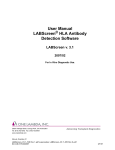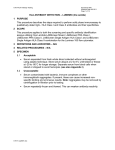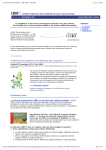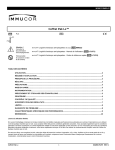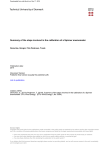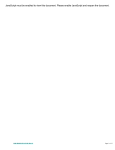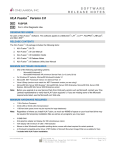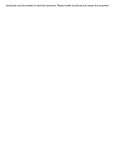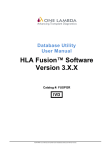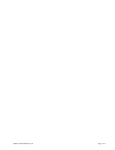Download LABScreen, ENGLISH VERSION
Transcript
21001 Kittridge Street, Canoga Park, CA 91303-2801 USA Tel: +1 (818) 702-0042 Fax: +1 (818) 702-6904 P R O D U C T www.onelambda.com I N S E R T LABScreen® See LABScreen® Reference Table for Product identification. For In Vitro Diagnostic Use. INTENDED USE LABScreen® products are intended for use in detection of HLA antibody using flow cytometric technology. SUMMARY AND EXPLANATION LABScreen® products use microbeads coated with purified Class I or Class II HLA antigens and pre-optimized reagents for the detection of Class I or Class II HLA antibodies in human sera. LABScreen® products utilize the Lambda Array Beads Multi-Analyte System® (LABMAS), which features the LABScan™ 100 flow analyzer, for data acquisition and analysis. The Mixed assay detects the presence of antibody to Class I and/or Class II HLA antigens. The PRA tests can detect antibodies and their specificities against the HLA antigens in each LABScreen® panel. The Single Antigen assay allows confirmation of antibody specificity suggested by a previous PRA test, while individual Singles beads are used to focus on reactions against one or a few antigens, e.g. to compare reactivity of different serum samples from the same individual. A negative control serum is used to establish the background value for each bead in a test batch. PRINCIPLE(S) LABScreen® products are used for antibody detection tests that utilize a panel of color-coded beads, which are coated with purified HLA antigens. Up to 100 different beads may be combined in one suspension for a single test. Test serum is first incubated with LABScreen® beads. Any HLA antibodies present in the test serum bind to the antigens and then are labeled with R-Phycoerythrin (PE)-conjugated Goat anti-human IgG. The LABScan™ 100 flow analyzer detects the fluorescent emission of PE from each bead, allowing almost real-time data acquisition. The reaction pattern of the test serum is compared to the lot-specific worksheet defining the antigen array to assign PRA and HLA specificity. REAGENTS A. Identification See LABScreen Reference Table for product description. B. Warning or Caution 1. For In Vitro Diagnostic Use. 2. Refer to the Material Safety Data Sheet for detailed information. 3. Warning: The LABScreen® PRA test reagents contain 0.1% sodium azide (NaN3) as a preservative. Under acidic conditions, sodium azide yields hydrazonic acid, an extremely toxic compound. Reagents containing sodium azide should be diluted in running water prior to being discarded. These conditions are recommended to avoid deposits in plumbing where explosive conditions may develop. 4. Warning: All blood products should be treated as potentially infectious. Source material from which this product was derived was found negative when tested in accordance with current FDA required tests. No known test methods can offer assurance that products derived from human blood will not transmit infectious agents. 5. Caution: For manual “flicking of trays, use a quick downward arm motion without wrist movement to prevent repetitive motion effects. C. Instructions for Use 1. See Directions for Use below. 2. If buffer salts have precipitated out of solution during shipment or storage, re-dissolve by gentle warming before preparing working dilution. D. Storage Instructions 1. LABScreen® products are shipped to the end user on dry ice. The entire package may be stored in a freezer at -65 C or below until first use, up to the labeled expiration date. 2. Once beads are thawed, DO NOT REFREEZE. Store at 2 - 8 C for up to three months or until the expiration date (if earlier). 3. After first use, store Wash Buffer at 2 - 8 C for up to three months or until the expiration date (if earlier). LS-LSCN-PI-EN-00, Rev. 17 Page 1 of 8 E. Purification or Treatment Required for Use See "Directions for Use" below. F. Instability Indications None. INSTRUMENT REQUIREMENTS A. Required Equipment LABScan™ 100 flow analyzer Luminex® XY platform (optional accessory for automated 96-sample reading on the LABScan™ 100 flow analyzer) Centrifuge Rotor for 1.5 ml microfuge tube (9300 g), or a swinging bucket rotor for 96 well microplate (1300 g) Vortex mixer Plate shaker or rotating platform For Filter-Plate Option: Millipore vacuum manifold (Millipore Cat. #MAVM0960R or equivalent) Millipore filter plate: (Multiscreen-BV, Millipore Cat. No. MABVN1210, or equivalent) Vacuum pump with a pressure less than 100 mmHg Plate shaker or rotating platform B. Equipment Calibration Follow manufacturer's instructions for calibration of the LABScan™ 100 flow analyzer. C. Recommended Software HLA Fusion® (OLI Cat. #FUSPGR) SPECIMEN COLLECTION AND PREPARATION A. Unopened blood specimens may be kept at room temperature up to 4 days. Separated serum (from clotted samples) or plasma (in ACD or K-EDTA) may be refrigerated up to 7 days, or aliquots may be frozen at -20°C or below, and thawed just before the assay. However, aggregates should be removed from the test serum/plasma by centrifugation (8,000 – 10,000 g for 10 minutes) or filtration (0.2 m) prior to testing. Any aggregates or contamination of the sample may generate invalid results. B. Test serum or plasma should not be heat inactivated, because it may give a high background in the test. C. Undiluted serum or plasma is generally used for the test. However, if a high background serum sample is diluted for this assay, the negative control serum should be tested at the same dilution. PROCEDURE A. Materials Provided – See LABScreen Reference Table for materials provided for each product. Note: The volumes provided are slightly more than the amount required for testing. This is to account for inadvertent losses that may result from pipetting. B. Materials Required, But Not Provided PE –Conjugated Goat Anti-Human IgG (OLI Cat# LS-AB2) PBS (filtered) 1.5 ml microfuge tube (USA Scientific) Pipette tips (Rainin GPS) If the test is performed in a 96-well plate: UNIPLATE, 96 wells, 250 l microplate (Whatman No. 7701-2250) or equivalent (non-treated surface) Tray seal (OLI Cat. #SSPSEA300) Negative Control Serum (OLI Cat. #LS-NC, or equivalent—containing no HLA antibody when tested by LABScreen® method). For Filter-Plate Option: Millipore filter plate: (Multiscreen-BV, Millipore Cat. No. MABVN1210, or equivalent) C. Step-by-step procedure. See "Directions for Use." LS-LSCN-PI-EN-00, Rev. 17 Page 2 of 8 DIRECTIONS FOR USE Notes: 1) Special care must be taken in the aliquoting process. Failure to follow the steps described below may result in reagent loss. 2) Sections A through C indicate the volumes of reagents needed for testing a single bead group. If you are running a combined test, see Section D before proceeding. 3) Turn on the LABScan™ 100 instrument at least 30 minutes before starting the assay. 4) Create a filename and sample code sheet for each test tray. A. To complete the test in a 1.5 ml microfuge tube: Note: See Section B below for instructions on using a 96-well plate. 1. The LABScreen® beads should be mixed well by gently vortexing or pipetting up and down several times prior to use. 2. Incubate 5 µl of LABScreen® beads with 20 µl of test serum in separate 1.5 ml microfuge tubes in the dark for 30 minutes at 20 - 25º C with gentle shaking. 3. For each test batch, a negative control serum (OLI Cat. #LS-NC or equivalent) should be tested to establish background values. 4. Dilute 10X wash buffer (Cat. # LSPWABUF) in distilled water to make a 1X solution. 5. Add 1 ml of 1X wash buffer to each bead/serum solution tube and vortex. Centrifuge at 9300 g for 2 minutes. Aspirate and discard the supernatant. 6. Repeat step 5 twice. 7. Dilute 1 µl per test of 100X PE conjugated anti-human IgG (Cat. #LS-AB2) with 99 µl of 1X wash buffer to make a 1X solution. 8. Add 100 µl of 1X PE conjugated anti-human IgG to each tube. Vortex and then incubate in the dark for 30 minutes at 20 - 25º C with gentle shaking. 9. Repeat step 5 twice. 10. Add 80 l PBS to each tube. The sample is ready for data acquisition and analysis, or it can be stored at 2 - 8º C in the dark for up to 24 hours before analysis. B. To complete the test in a 96-well plate: Caution: Sealing of the 96-well tray should be done carefully and completely to prevent well-to-well sample contamination. Seal the tray by pressing the seal against each rim of the 96 wells. Do not re-use tray seals. Use a fresh seal for each step that requires application of a tray seal. 1. The LABScreen® beads should be mixed well by gently vortexing or pipetting up and down several times prior to use. 2. Incubate 5 µl of LABScreen® beads with 20 µl of test serum in each well of a 96-well plate in the dark for 30 minutes at 20 - 25º C with gentle shaking. 3. For each test batch, a negative control serum (OLI Cat. #LS-NC or equivalent) should be tested to establish background values. 4. Dilute 10X wash buffer (Cat. #LSPWABUF) in distilled water to make a 1X wash solution. 5. After incubation, add 150 l of 1X wash buffer to each well of the plate. Cover with tray seal (OLI Cat. # SSPSEA300) and vortex. Centrifuge at 1300 g for 5 minutes. 6. Remove wash buffer from wells of plate by flicking or with vacuum aspiration. 7. Add 200 l of 1X wash buffer to each well of the plate. Cover with a new tray seal and vortex. Centrifuge at 1300 g for 5 minutes. 8. Remove wash buffer from wells of plate by flicking or with vacuum aspiration. 9. Repeat steps 7 and 8. 10. Dilute 1 µl per test of 100X PE conjugated anti-human IgG (Cat. # LS-AB2) with 99 µl of 1X wash buffer to make a 1X solution. 11. Add 100 µl of 1X PE conjugated anti-human IgG to each well. Cover with tray seal and vortex. Incubate in the dark for 30 minutes at 20 - 25º C with gentle shaking. 12. Centrifuge at 1300 g for 5 minutes. 13. Remove 1X PE conjugated anti-human IgG from wells of plate by flicking or with vacuum aspiration. 14. Repeat steps 7 and 8 twice. 15. Add 80 l 1X PBS to each well. Cover with a new tray seal and vortex. The sample is ready for data acquisition and analysis, or it can be stored at 2 - 8º C in the dark for up to 24 hours before analysis. C. To complete the test in a 96-well filter plate: LS-LSCN-PI-EN-00, Rev. 17 Page 3 of 8 1. 2. 3. 4. 5. 6. 7. 8. 9. 10. 11. 12. 13. 14. Dilute 10X wash buffer (Cat. # LSPWABUF) in distilled water to make a 1X solution (approximately 3.2 ml/tray/wash). Cover any wells of the plate, which will remain unused during the test, with a tray seal to assure that the unused wells remain dry. Pre-wet filters in the filter plate by dispensing 300 l wash buffer into only those wells that will be used for the assay. Incubate the plate for 10 minutes on a platform plate shaker at low speed. Aspirate all wash buffers from the wells using a Millipore vacuum manifold. Do not exceed 100 mmHg vacuum pressure! Add 5 µl of LABScreen® beads with 20 µl of test serum per test well of the plate. a. Vortex or gently pipette up and down to mix well LABScreen® PRA beads prior to use. b. For each test batch, a negative control serum (OLI Cat. #LS-NC or equivalent) should be tested to establish background values. c. During bead and sample dispensing steps, press pipette tips gently against the filter plate wells to avoid rupture of the filters. Incubate in the dark for 30 minutes at 20 - 25º C with gentle shaking. Add 275 l wash buffer per well. (Less may be required based on sample and bead volume already in the well.) Turn on vacuum pump. Do not exceed 100 mmHg vacuum pressure! Press the plate firmly on the vacuum manifold. Make sure liquid drains out slowly. A rapid vacuum will cause loss of beads due to be entrapment in the pores of the filter paper. Make sure all liquid has drained from the wells before you proceed to the next wash step. Repeat steps 7-8 above 4 additional times. Add 100 l of l of 1X PE conjugated anti-human IgG to each well. Incubate in the dark for 30 minutes at 20 - 25º C with gentle shaking. Repeat steps 7-8 five times. Add 80 l of 1X PBS to each well. Read sample on the LABScan™ 100 machine, adjusting probe height if necessary. D. Combined tests: 1. Any of the above protocols can be used for a Combined Test for certain products. (See LABScreen® Bead Combination Table on the One Lambda, Inc. web site for acceptable lot combinations.) 2. For the Combined Class I and Class II test (OLI Cat. #LS12PRA) use 5 l of each bead suspension with 40 l of test serum. 3. To combine any two Single Antigen bead groups, use 5 l of each bead group and 20 l test serum. 4. To combine any three Single Antigen bead groups, use 5 l of each bead group and 30 l test serum. Note: Equal volumes of beads can be mixed first. Then dispense the appropriate aggregate amount (10 or 15 ul) of bead mixture per test. 5. LABScreen Single Antigen Class I Combi and Class II panels can not be combined since bead IDs would overlap. 6. Options for bead combinations and amounts to dispense are listed in the Table below. Catalogue ID LS12PRA (CI and CII beads) LS1A01, LS1A02, LA1A03 (any two) LS1A01, LS1A02, LA1A03 (all three) LS1A04 See option D.3 below. Bead volume per Test Control (NC/PC) beads 5 l + 5 l 5 l + 5 l Included 5 l Sample volume per Test 40 l 20 l 5 l + 5 l + 5 l 5 l * 30 l* 5 l Included 20 l D. LABScreen® Singles: The assay is essentially the same as outlined above. However, please note: 1. Use the Singles beads for those situations where you want to examine reactions against only one or a few single antigen(s). 2. When running 1 or 2 Singles beads, add 5 l of the selected Singles beads and 5l if LABScreen® Singles Control (NC/PC) beads to each tube, with 20l of test serum. 3. Option: If combining more than two Singles beads centrifuge the mixture (plus Controls) at 5,000g for 5 min.; aspirate the supernatant leaving 5l of supernatant. Re-suspend the beads. Then, add 20 l of test serum. 4. For Data acquisition, select either the LABScreen Single Antigen Class I Combi or Class II panel template, as appropriate. Keep collecting data on each sample until the automatic time out is reached. 5. If not running a negative control serum, use the LS-NC default values published in the LS-NC Datasheet for LABScreen® LS-LSCN-PI-EN-00, Rev. 17 Page 4 of 8 Single Antigen Class I Combi or Class II beads to calculate the NBG ratio. Note: Class I and Class II Singles beads should not be combined. RESULTS A. Data Acquisition 1. Set up the LABScan™ 100 for sample acquisition and calibration according to the Luminex User’s Manual1. 2. Choose a template according to product kit catalog ID and lot number. a. Acquisition templates are available from OLI by CD or downloadable via our download website. b. To create your own acquisition template, follow instructions in the Acquisition chapter of the Luminex Users Manual: 3. Create a file name for the samples to be run. 4. Make sure all the template settings are correct. Template specifications are: a. Sample volume set to 50 l. b. Sample time-out set to 80 seconds. c. Doublet discriminator gate set to 8000 (low limit) and 16000 (high limit). d. Number and ID of beads selected according to the product-specific worksheet provided with the product. e. Minimum events collected set to 100 per bead. f. Flow rate set to FAST if you are using Luminex® Version 1.7. (This does not apply to Luminex® IS versions.) 5. Enter the sample IDs. (Caution: If the same sample is tested more than once, a different ID should be assigned.) 6. The plate is now ready to run. 7. Load the plate onto the XY platform and fill the reservoir with sheath fluid. 8. Click on the START button to initiate the session. After the samples have finished running, the data output should be saved in a .csv file. 9. Wash the machine 2 times with sheath fluid at the end of the session. B. Data Analysis 1. Each serum’s reactivity can be assessed by the fluorescent signal for each HLA coated bead after correction for nonspecific binding to the negative control (NC) bead (#001). All data is normalized to the results obtained using negative control serum (OLI Cat #LS-NC). 2. The reactivity of a test sample is calculated based on the fluorescence values, which can be obtained from the .csv file. 3. For LABScreen® PRA, LABScreen® Single Antigen, or LABScreen® Singles, the normalized fluorescent value for each HLA coated bead equals the value of that bead divided by the value of the NC bead. a. For LABScreen® Mixed, the normalized fluorescent signal equals the value of the Class I or Class II coated bead minus the value of the NC bead. 4. The background values for each HLA bead and the NC bead are obtained by testing with a negative control serum. 5. The strength of the anti-HLA reactivity is assigned by the normalized background ratio (NBG ratio). (See calculations below). Note: The fluorescent signal (value) can be either the trimmed mean or median value. C. Calculations 1. The abbreviations used in this section are defined below: NBG ratio S#N SNC bead BG#N BGNC bead NC Serum LS-LSCN-PI-EN-00, Rev. 17 Normalized Background ratio used to assign strength of each anti-HLA reaction Sample-specific fluorescent value for bead #N Sample-specific fluorescent value for Negative Control bead Background NC Serum fluorescent value for bead #N Background NC Serum fluorescent value for Negative Control bead Negative Control Serum (OLI Cat. # LS-NC) validated for a given lot of LABScreen® beads Page 5 of 8 2. For LABScreen® PRA or LABScreen® Single Antigen or Singles Products: S#N / SNC bead NBG ratio = BG#N / BGNC bead For LABScreen® Mixed: NBG ratio = S#N - SNC bead BG#N - BGNC bead Note: If (BG#N-BGNC bead) <50 then use 50 as a default threshold value. D. Determination of Positive/Negative Cut-Off 1. For LABScreen® PRA and LABScreen® Mixed: a. Select the NBG ratio that gives a significant shift over background fluorescent value when the background value is obtained using the negative control serum in 3 - 5 replicate tests. If you prefer, test 5 - 10 serum samples from non-transfused, non-transplanted male donors to obtain an average background value. b. Validate the cut-off using 5 - 10 reference alloserum samples with defined HLA antibody specificity. The NGB ratio values for the expected positive antigen reactions should be above the cut-off. c. Additional positive/negative reactions may be noted. If necessary, adjust the LABScreen® assay cut-off to match the sensitivity of a previously accepted antibody detection assay. d. For high PRA serum, the patient’s own antigen(s) may show weak positive reactions. For such cases, the fluorescence value for the patient’s own antigen may be used as the cut-off point. 2. For LABScreen® Single Antigen: a. Test negative control serum or several negative serum samples by using 1a above. b. Define working range: Working Range = NBG ratio maximum - NBG ratio minimum c. Define cut-off points within the working range: Relative NBG ratio cut-off = X%(working range) + NBG ratio minimum, where X% = user-defined percent cut-off point within the working range for negative(1), gray area(2), weak positive(4) and strong positive(8). d. Set criteria to define positive vs. negative reactions, for example: (1) If [NBG ratio max/NBG ratio min] >8, then apply the calculation in 2c. (2) If [NBG ratio max/NBG ratio min] <8 AND i. NBG ratio max >5, then NBG ratio min should be adjusted to one half of the NBG ratio max and the relative NBG ratio cutoff should be re-computed (as in 2c) based on the adjusted NBG ratio min. The reaction is then scored as above. ii. NBG ratio max <5, then the reaction of the test serum with that bead is negative. Assign a score of “1". e. Test several reference allosera as in 1b above, using the relative NBG ratio to validate the cut-off. (1) Establish a strong and weak reactivity cut-off based on the performance of the reference allosera, relative to an established assay. (2) It may be helpful to plot the NBG ratio values in a histogram for visualization of the HLA reactivity pattern of each serum. 3. Higher or lower sensitivities can be obtained by adjusting the cut-off. 4. For LABScreen® Singles: a. The LABScreen® Single Antigen Class I Combi and Class II panels can be used to identify the specificity of the serum. Since the LABScreen® Singles beads are coated with the same antigens, the reactivity should be similar for these products. b. Alternately, use the same patient’s serum from a specific draw date to establish a baseline reading fro comparison with test sample. LS-LSCN-PI-EN-00, Rev. 17 Page 6 of 8 EXPECTED VALUES A. LABScreen® PRA Class I or Class II 1. The reactivity strength of a test serum to each bead can be compared to distinguish the strong positive, weak positive and negative reactions. Reactivity ratios can be ranked within different ranges, if a scoring system is desired. 2. Our data show NBG ratios > 1.5 in the LABScreen® PRA test correlate well with positive reactions in the FlowPRA® test. 3. For calculation of percent PRA (Panel Reactive Antibody), divide the number of positive reactions by the number of valid reactions for that test serum. 4. To determine the specificity of HLA antibody enter the reaction score into the lot specific Worksheet to analyze the reaction pattern. B. LABScreen® Mixed 1. Score HLA Class I and Class II reactions separately, according to the reactivity strength of the serum for each bead set. 2. If any one bead in the mixed assay is positive, then the result should be assigned as positive. 3. Our data show that NBG ratios >2.2 in the LABScreen® Mixed test correlate well with positive reactions in LAT™ Mixed. C. LABScreen® Single Antigen and Singles Products 1. Allosera may produce Signal/Background ratios that are much higher than those obtained in the PRA assay. Establishing the assay cut-off(s) using the relative NBG ratio (as in Results, section D-2c) is one way of normalizing the data. 2. Our data show that a positive/negative cut-off or relative NBG ratio >15% of the working range NBG ratio calculated for each test serum will give results comparable to the LABScreen® PRA assay. 3. Reactivity of individual Singles beads should be similar to the corresponding beads in the Single Antigen Class I Combi and Class II panels. D. General Guidelines 1. Each bead count should be over 50. A lower bead count may be due to sample loss during the wash steps. It could also be due to improper calibration or clogging of the LABScan™ 100. Low beads count could also be caused by photo-bleached beads that dropped out from the mapped region. 2. Signal values are the fluorescence intensity of each bead set vs. the test serum. A negative control serum should be tested with the same batch of samples to establish the background value(s) for that test run. 3. Negative Control Serum (OLI Cat. #LS-NC or equivalent) is recommended. Using any other negative control serum may require adjustment of cut-off values. 4. Negative Control Beads (Ag ID = NC) are not coated with HLA antigen. The fluorescence value may vary among different sera due to non-specific binding of the sera or to insufficient washing. The NC value is usually less than 500 except for serum samples with a high background. It should always be lower than 1500 and less than or equal to half of the PC value. 5. Positive Control Beads (Ag ID = PC) are beads coated with purified human IgG. It should bind to the secondary antibody to produce a positive signal. The PC value should be over 500 and at least twice the NC value. E. Validation of the Assay 1. The cut-off value of signal to background should be validated if a new negative control serum is used. 2. For a given serum, the value for PC/NC should be greater than 2. A lower value may be due to an extremely high NC bead background value for the test serum, a high HLA bead signal for the NS control, or a low signal from the secondary antibody or the LABScan™ 100 system. In this case, the data may have to be confirmed. 3. Each user should evaluate the performance of the assay in their laboratory to validate the cut-off value(s) selected. 4. Plasma samples may give lower FI or higher background values than serum. The user may wish to normalize the data if comparing results between sera and plasma samples (see reference 5) for the same or different test subjects. LIMITATIONS OF THE PROCEDURE A. Sera or plasma samples that contain contaminants or aggregates may clog the LABScan™ 100 and generate inaccurate data. Aggregates in the test specimen should be removed by centrifugation or filtering the serum prior to testing. B. Ambient temperature where the LABScan™ 100 is located may affect machine calibration. If the ambient temperature changes, the machine may need to be re-calibrated. Consult the manufacturer's manual for more information. C. Accurate data acquisition depends on proper performance of the LABScan™ 100. The machine has to be properly calibrated and maintained. In case of insufficient flushing of the system, aggregates of the sample may cause the machine to clog and generate invalid data. D. Assignment of antibody specificity is limited to the HLA antigens presented in each bead panel. (See lot-specific LS-LSCN-PI-EN-00, Rev. 17 Page 7 of 8 worksheet.) E. The bead region used for each antigen and the antigen composition of the panel may change from lot-to-lot of product, (See the lot specific Worksheet). SPECIFIC PERFORMANCE CHARACTERISTICS A. Using the assay cut-offs referenced under Expected Values, the LABScreen® assays have given results comparable to the results of the One Lambda FlowPRA® and Lambda Antigen Tray™ assays. However, HLA antibody patterns may be quite complex. A given test sample may contain several HLA Class I and Class II antibody specificities, each with a different avidity; however, not all specificities will be recognized in assays with lesser sensitivity. Therefore, each laboratory should establish and validate the assay cut-offs for their own use based on their expertise in recognizing HLA CREG patterns and an evaluation of the assay performance using HLA allosera with defined specificities. B. Comparison of serum vs. plasma for 1,000 blood donors in the NIHLBI REDS-II study (5) showed good correlation within the working range of the assay. For anti-HLA CI and CII antibodies the R2 values were 0.88 and 0.91, respectively. However, the NBG ratio was generally 1.3-fold higher for serum samples. BIBLIOGRAPHY 1. The Luminex® 100 or 200 User’s Manual, Luminex Corporation, PN 89-00002-00-005 or PN 89-00002-00-109. 2. R Pei, J-H Lee, T Chen, S Rojo, and PI Terasaki. Flow Cytometric Detection of HLA Antibodies Using a Spectrum of Microbeads. Human Immunology 60, 1293-1302 (1999). 3. R Pei, G Wang, C Tarsitani, S Rojo, T Chen, S Takemura, A Liu, and J-H Lee. Simultaneous HLA Class I and Class II antibodies screening with flow cytometry. Human Immunology 59, 313-322 (1998). 4. RA Bray, DA Sinclair, L Wimoth-Hosey, C Lyons, P Chapman and J Holcomb. Significance of the flow cytometric PRA in the evaluation of patients awaiting renal transplantation. Department of Pathology, Emory University, Atlanta, GA. ASHI abstract, 1998. 5. PJ Norris, J-H Lee, D Carrick, JL Gottschall, M Lebedeva, R De Castro, SH Kleinman, and MP Bish. Long-term in vitro reactivity for HLA antibodies and comparison of detection using serum vs. plasma. Transfusion. In press (2008). TRADEMARKS AND DISCLAIMERS ™LABScan, and Lambda Antigen Tray are trademarks of One Lambda, Inc. ®Luminex is a registered trademark of Luminex Corporation. ® FlowPRA, LABScreen, and LABMAS are registered trademarks of One Lambda, Inc. All One Lambda products are designed to assist personnel experienced in HLA analysis by suggesting typing results or antibody assignments. All test results must be carefully reviewed by such qualified personnel to assure correctness. EUROPEAN AUTHORIZED REPRESENTATIVE MDSS GmbH, Schiffgraben 41, D-30175, Hannover, Germany REVISION HISTORY Revision Date 16 2010/03 17 2010/08 LS-LSCN-PI-EN-00, Rev. 17 Revision Description Update Reagent Section D.” Storage Instructions” to include a statement to store Wash Buffer at 2-8°C after first usage for 3 months or until the expiration date (if first). Update temp from 2-5⁰C to 2-8⁰C to process trays thru Luminex machine (PCR#287) and add limitation statement currently included in lot specific worksheets (PCR#288); removed revisions 9-15 from Revision History table. Page 8 of 8










